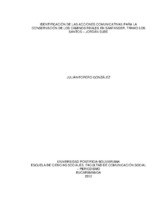Identificación de las acciones comunicativas para la conservación de los caminos reales en Santander, tramo los Santos - Jordán sube
Fecha
2014-09-10Director/Asesor
Pallares Espinosa, Jaime Enrique
Tipo de contenido
bacherlorThesis
Citación
Metadatos
Mostrar el registro completo del ítemDocumentos PDF
Resumen
Los caminos reales en Santander fueron hacia el Siglo XVI, XVII y XVIII, el medio vial más usado por los amerindios y españoles para la comunicación y comercialización de sus productos entre el centro y oriente del país. Debido a la riqueza histórica y cultural que aportan estos Caminos Reales a la memoria del pueblo colombiano, y en especial a los santandereanos, es fundamental desarrollar entre los habitantes y los entes departamentales, una estrategia comunicativa que permita la activación de estos bienes patrimoniales por medio de la difusión, y que conlleven a su misma conservación. Uno de los principales motivos de esta investigación es llamar la atención de la Gobernación de Santander para que genere acciones comunicativas que permitan la protección y conservación de este bien patrimonial, que se encuentra ubicado por toda la geografía santandereana. Es ahí donde se pretende tomar a la comunicación como herramienta principal, que permita el buen desarrollo de las actividades socio - culturales de los santandereanos. Se realizó un estudio exploratorio – descriptivo, con un enfoque metodológico mixto con técnicas de recolección tales como: fotografía y metodología, la encuesta y entrevista en profundidad, y se usaron dos herramientas fundamentales para la recolección de datos; la cámara fotográfica, testigo fiel de la historia y la entrevista, instrumento de indagación e investigación profunda. En Santander, la destrucción y el desaprovechamiento de los Caminos Reales, están ocasionando una gran pérdida del pasado, la falta de inversión por parte de las entidades departamentales, están arrancando la memoria, enterrando la identidad y desplazando la cultura, hacia un abismo profundo de donde salir será imposible sin la activación de la participación ciudadana. The Royal Road was in Santander around to XVI, XVII and XVIII, the most way used by the Amerindians and Spanish for communication and marketing of their products between the center and east of the country. Due to historical and cultural richness that they bring theses royal roads to the memory of the Colombians and particularly to Santander people, it is essential to develop between the public and departmental authorities a communicative strategy to allow the activation of these heritage assets through diffusion, and to lead its own preservation. One of the main reasons for this research is to draw the attention of the Government of Santander to generate a communicative strategy to enable the protection and conservation of this heritage asset that it is located across the geography of Santander. This is where we pretend to take as the main tool of communication that allows the development of social and cultural aspects of Santander people. Exploratory and descriptive study was taken as methodological approach with data collection techniques such as: photography and methodology, survey and in-depth interviews and it was used two fundamental tools for collecting data, the camera, a witness of the history and interview instrument of inquiry and thorough investigation. In Santander, the destruction and waste of Royal Roads are causing a great loss of the past, lack of investment by departmental entities are pulling up the memory, burying the identity and moving the culture toward a deep abyss that it will be impossible go out without the activation of citizen participation.
Palabra/s clave
Comunicación social
Tesis y disertaciones académicas
Informes de investigación
Gobernación de Santander
Patrimonio cultural
Caminos
Comunicación
Periodismo
Colecciones
- Trabajos de grado [6698]


